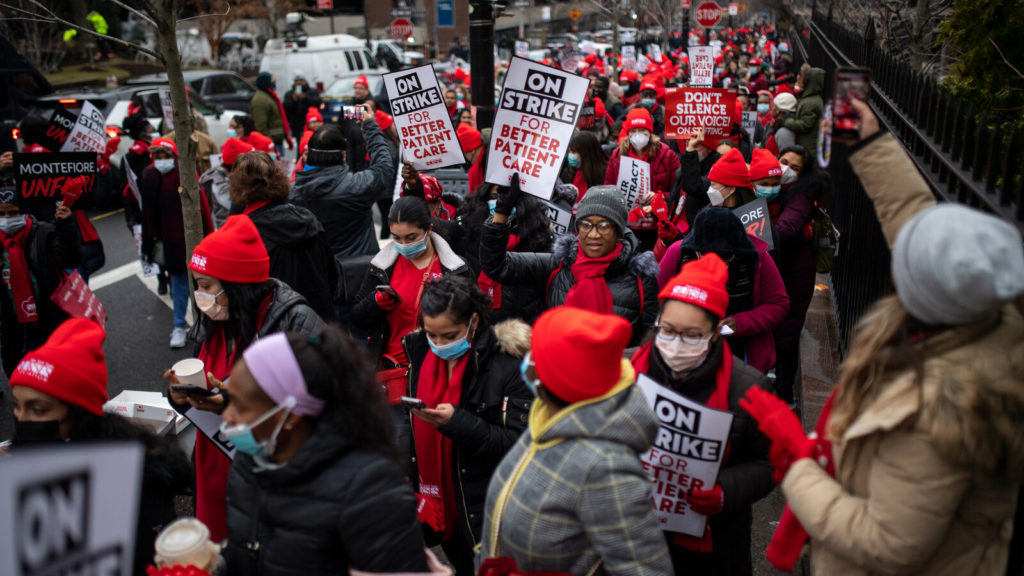More than 7,000 nurses at Mount Sinai Medical Center and Montefiore Medical Center are seeking better wages and working conditions.

Hundreds of striking nurses and their supporters lined both sides of Madison Avenue in front of Mount Sinai Hospital on Monday, waving signs, blowing horns and calling for a labor contract that will require more nurses at the bedside for patients.
The nurses, members of the New York State Nurses Association, went on strike at 6 a.m. Monday after talks with Mount Sinai management broke down in the early morning hours. Nurses also went out on strike at the three campuses of the Montefiore Medical Center in the Bronx over similar issues of pay and staffing. Nurses at eight other city hospitals were able to reach tentative contract deals and did not strike.
Monday’s labor action, involving more than 7,000 nurses, represented the largest nursing strike in decades in New York City, and comes as nurses are increasingly turning toward walk outs as a labor strategy, both nationally and abroad. Nurses, who both saw how valued they were during the darkest days of the Covid-19 pandemic, and who struggled with exhaustion and burnout, said they were standing their ground to improve conditions both for themselves and their patients.
“We are not out here for wages, we are out here because we want patient safety,” said Lorena Vivas, who has been a nurse for 19 years.
Ms. Vivas joined her fellow nurses, union leaders and local elected officials on the picket line in front of Mount Sinai, wearing bright red hats and scarves and shouting over the sounds of air horns and cheers. Letitia James, the state attorney general, and Mark Levine, the Manhattan borough president, were among the officials standing with the strikers.
Ms. Vivas said she was often caring for three or four patients at a time in intensive care instead of the one or two she is supposed to. “This has been going on even before the pandemic,” she added, “and the pandemic just blew the whole thing open.”
The problem of understaffing at hospitals has been building for years, with nurses leaving emergency rooms and in-patient wards for higher paying jobs as temporary nurses or less stressful positions in outpatient settings. The Covid pandemic, which is now being accompanied by a surge in winter admissions of patients with flu and R.S.V., compounded the strain.
At Mount Sinai, union leaders said, emergency room nurses can care for as many as 18 patients at a time. At Montefiore, patients are kept in hallways so often that management has installed televisions there, the union said. They said nurses will return only if the hospital agrees to improving working conditions.
Hospital management says it is doing what it can given a national nursing shortage.
“The challenges of hiring and growing a talented health care work force can’t be overstated and were exacerbated by the pandemic,” said Lucia Lee, a spokeswoman for Mount Sinai, explaining why there were hundreds of vacancies. She said the hospital had implemented “unprecedented recruitment strategies” in recent years.
As it became clear this week that a strike was likely, Mount Sinai and Montefiore rushed to bring in temporary staff to continue operations, even pressing doctors into service to fill nursing gaps. In a statement on Monday, Montefiore Medical Center said the union’s leadership had “decided to walk away from the bedsides of their patients,” despite management’s offer of a 19.1 percent compounded wage increase and its offer to create more than 170 new nursing positions.

“We remain committed to seamless and compassionate care, recognizing that the union leadership’s decision will spark fear and uncertainty across our community,” the statement said.
Judy Sheridan-Gonzalez, a nurse on the negotiating committee at Montefiore, said that the hospital had called nurses back to the negotiating table on Monday afternoon after seeing hundreds of nurses gathered outside the main campus on Monday morning.
Labor Organizing and Union Drives
- A Union Win: Organized labor claimed a big victory on Jan. 3, gaining a foothold among about 300 employees at a video game maker owned by Microsoft.
- Education: Academic employees at the University of California voted to return to work, ending a historically large strike that had disrupted research and classes for nearly six weeks.
- U.K.’s ‘Winter of Discontent’: As Britain grapples with inflation and a recession, labor unrest has proliferated, with nurses, railway workers and others leading job actions across the country.
- Electric Vehicles: In a milestone for the sector, employees at an E.V. battery plant in Ohio voted to join the United Automobile Workers union, citing pay and safety issues as key reasons.
Nurses on the picket line in the Bronx described overcrowded, understaffed conditions. “It’s unsafe because, in the emergency room, how can a nurse safely monitor 20 patients?” said Johnaira Dilone-Florian, a nurse practitioner. “Anything can go wrong. We are human, we’re not machines.”
Negotiations have been going on for four months, Ms Sheridan-Gonzalez said, but movement toward union demands of enforceable staffing ratios and recruitment bonuses to compete with higher pay at nearby NewYork-Presbyterian Hospital only happened in the last few days.
“I don’t think they thought we were going to go out,” she said.
On Sunday night, Gov. Kathy Hochul called for binding arbitration “so that all parties can swiftly reach a resolution.” Officials from both hospitals said they would welcome arbitration and hoped the nurses’ union would agree and postpone its strike deadline, but union officials did not accept the offer.
“Gov. Hochul should listen to frontline Covid nurse heroes and respect our federally protected labor and collective bargaining rights,” union officials said in a statement.
The pandemic has left some frontline medical workers with deep distrust for management. In New York City, many nurses and doctors who worked through the first wave of the pandemic have not forgotten the conditions when Covid first swept through the city in early 2020, overwhelming hospitals with a surge of patients and killing more than 22,000 people. In Britain, nurses went on strike last month for the first time in the 74-year history of the country’s National Health Service.
Nancy Hagans, the president of the New York State Nurses Association, said hospitals’ failure to hire new nurses has left hundreds of unfilled slots, including more than 700 openings at Montefiore and 500 at Mount Sinai.
“Our No. 1 issue is a crisis of staffing,” she said, adding, “It is an issue that our employers have ignored.”
Nurses’ contracts expired on Dec. 31 at a dozen private hospitals in the city, and the union authorized a strike at some of them and sent the hospitals a 10-day notice. On Sunday, two other Manhattan hospitals, both run by the Mount Sinai Health System — Mount Sinai Morningside and Mount Sinai West, both on the West Side — reached a tentative settlement with the union, which included a 19.1 percent wage increase over three years.
Hospital officials said they had made the same offer, which provided an additional $51,000 in cash compensation for each nurse and $19,500 in medical payment benefits over three years, to nurses at the Mount Sinai Hospital on Fifth Avenue.
Union officials, however, said that there were still differences with seniority payments at Mount Sinai’s main campus, and that nurses there tend to earn less than they do at the two other Mount Sinai campuses.
Matt Allen, a labor and delivery nurse on the union negotiating team at Mount Sinai, said that the main sticking point was the establishment of enforceable nurse-to-patient ratios. Currently, he said, there are staffing plans that detail how many patients each nurse should care for, but they are not routinely enforced.
A new state law requires hospitals and nursing homes to maintain safe staffing ratios, but the pandemic has delayed its enforcement. On Monday, Ms. James, the attorney general, called on the state’s Department of Health to enforce the law in a speech at the Mount Sinai strike.
“They do not want to put any patients in harm’s way,” Ms. James said of the nurses. “What they want to do is improve safety in this hospital and other hospitals not only in the city but across the state.”
The union also recently reached tentative agreements with Richmond University Medical Center, Flushing Hospital Medical Center, BronxCare and the Brooklyn Hospital Center, and agreements have been ratified at NewYork-Presbyterian and Maimonides Medical Center. Negotiations continue with Interfaith Medical Center, Kingsbrook Jewish Medical Center and Wyckoff Heights Medical Center, all in Brooklyn.
In recent days, hospitals scrambled to make arrangements for the looming strike, including discharging all the patients they safely could, bringing in substitute nurses, postponing many elective surgeries and diverting ambulances to other hospitals.
Mount Sinai began moving some vulnerable patients, including fragile newborns in neonatal intensive care units, to other hospitals, and helped cancer patients find alternative treatment locations.
Mayor Eric Adams said in a statement Sunday night that the city was communicating with the hospital systems, but said the hospitals in some areas of the city would likely be strained.
“We encourage all New Yorkers to call 911 only for emergencies, and be prepared to seek an alternate facility in case their preferred hospital is impacted,” he said.
Mount Sinai officials said in a statement that their bargaining teams at three hospitals have met with the nurses’ union more than 40 times since September. They added that a strike would “place even more strain on New York City’s emergency departments and health systems during a time of crisis.”
One striking nurse outside Mount Sinai, John Adriel, 28, said that on the step-down floor where he tends to recovering patients, some on life support, he worries about their well-being and his own because there aren’t enough nurses.
“The patient-to-nurse ratios are unsafe,” Mr. Adriel said. “Every time I go into work, truly I’m scared for my license.”
Margit Anderegg, a labor and delivery nurse at Mount Sinai, said she was striking as a way to show solidarity with her colleagues in the emergency department, who she said sometimes have to care for 18 patients each.
“Mount Sinai is trying to spin us like we are being greedy and abandoning our patients, but we can’t work under those conditions, and it’s been going on for years,” she said.
By Sharon Otterman (The New York Times)















1 Comment
mplrs.com
Thx.
Comments are closed.